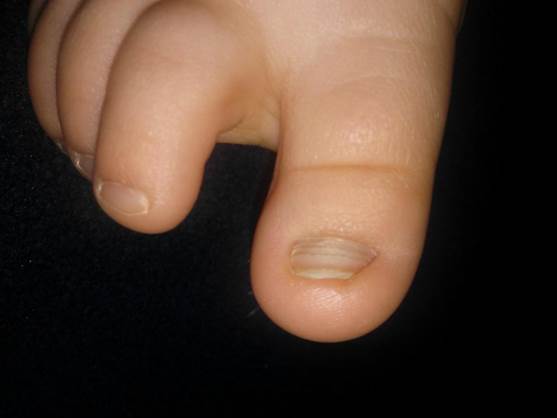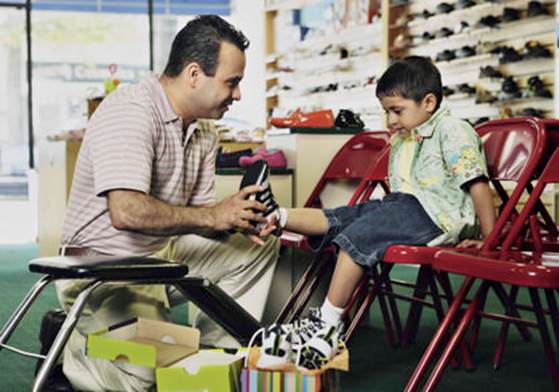How to deal with the trials and
tribulations of growing feet
Ankle sprains and strains: A sprain happens when the ankle or knee is pushed or wrenched
beyond the normal range; a ligament can be torn or injured.
A strain is an injury to a muscle, tendon
or ligament that is overstretched or twisted beyond its capacity.
Both create pain, swelling and get blue and
the treatments are the same:
Remove shoes. Use RICE – Rest, Ice,
Compress (with an elastic bandage), and Elevate. Keep your child off his feet.
After about a day apply a hot moist pad to promote healing and gentle exercise.
If you suspect that a bone is broken, take
an X-ray. If swelling and pain don’t subside in a few days, see a doctor.
Athlete’s foot: It’s caused by fungi that flourishes a warm sweaty feet, especially
around swimming pools. Your child is left with cracked or peeling soles,
itching, burning or sometimes blistering, especially between the toes and on
the soles.
You need to wash the feet with soap and
water after swimming and during a bath. Separate the toes and gently rub away
the peeling skin with a towel. Dry well! Sprinkle the area between toes with an
antifungal powder (Surfaz) or baby powder. Repeat when the feet get sweaty and
damp. Remember the more air circulates around the fungi, the faster they will
die.

Dry
well! Sprinkle the area between toes with an antifungal powder (Surfaz) or baby
powder
Blisters:
These small fluid filled thingies form on sides of heels or soles. The
culprits? Ill-fitting shoes
Resist the temptation to puncture. The
fluid will be reabsorbed slowly. Clean the skin and apply a dry sterile gauze
pad. If it breaks, wash with antiseptic soap (Dettol), and apply the sterile
gauze pad. Don’t peels away dry covering skin? Try to protect it from friction.
If it reddens or produces pus, see a
doctor.
Corns and calluses: These small dead skin build ups or thickened areas of skins are
caused by – no prizes for guessing – too tight shoes and high heels. Hard corns
hit the tops of toes where the shoes press; soft corns develop between the
toes; calluses form on heels or balls of the feet.
Soak in warm water for 15 minutes, and then
gently rub with a pumice stone. Apply Vaseline.
Don’t use commercial corn plasters on tiny
tender feet.
Ingrown toe nails: These are nails that grow into and cut the skin and are caused by
too short cutting or injury. They can be red and painful. Shoe pressure
aggravates the ouch factor.
Bathe the foot in a bowl of warm water with
a handful of table salt. Soak a bit of absorbent cotton in an antiseptic cream
(Soframycin, Neosporin) and push under to edge.
If the skin around the toe becomes swollen
or inflamed, hot to touch, leaks pus, it is infected and needs a doctor’s
attention.

These
are nails that grow into and cut the skin and are caused by too short cutting
or injury.
Plantar warts: These nasties which are brown or grey with a black center develop
on the sole of the foot where they are usually flattened by the pressure of
walking and are surrounded by thickened skin. They tend to be hard and flat
with a rough surface and well defined boundaries.
The warts may also target the top of the
foot or the toes where they are usually raised or fleshy. Your child can pick
them up at swimming pools and they disappear spontaneously within two years.
If painful your doctor can remove them with
salicylic acid or freeze them with liquid nitrogen.
Never try to economize by buying a
larger size for the child to grow into, which can cause tripping or limping
Shoe sense
For starters, your baby doesn’t need shoes,
cross the medical expert’s heart.
The longer she walks without shoes, the
better will her feet develop naturally, build up arches, strengthen ankles. So
let her go barefoot at home till she’s two, and on the beach, the sand pit, the
lawn.
If your baby first walks only on flat
floors encased in smooth booties she is apt to emerge flat footed.
First shoes should have semi soft soles,
non-skid bottoms to give her a better chance to move. Keep a margin of one to
two cm between big toe and front of shoe, and see that they’re wide enough so
that all toes lie flat, so the shoes are not cramped, but make sure that they
don’t slip off. Measure every 6 to 8 weeks, because tiny feet grow two full
sizes until four.

Measure
every 6 to 8 weeks, because tiny feet grow two full sizes until four
As your child grows go shoe shopping in the
latter half of the day because feet swell slightly in the course of the day.
Measure when standing. Never try to economize by buying a larger size for the
child to grow into, which can cause tripping or limping.
Schools provide guidelines for sensible
shoes, so don’t battle with them. Avoid backless sandals, slip-ons and
specially heels, which are bad for proper foot development. There is plenty of
variety and color in flexible flats to choose from. Replace regularly.
Feet for life
Give your child a get-set-go start.
·
Teach to toe straight from the beginning. Toeing
in or out weaken the feet and throws the body out of kilter.
·
Wash feet twice a day with soap and warm water.
Dry thoroughly specially between the toes. Dust clean feet lightly with talcum
powder.
·
Clean white socks absorb sweat. Change daily
(twice if going out for sports). Socks should be 1 cm larger than the longest
toe, in a standing position.
·
A warm foot bath laced with vinegar cuts down
foot odor.
·
Keep shoes clean. Sprinkle smelly shoes with
baking powder. Shake out before use.
·
Cut toe nails after a bath, straight across. Don’t
bend around the curves.
·
Always cover feet around a swimming pool or pond
to protect against athlete’s foot, planter’s wart, leptospirosis (a serious
illness passed on by dog, cat and rat urine).
·
Check out ankles and legs with a pediatrician
regularly, from the time your baby stands.